- Joined
- Jun 22, 2017
- Messages
- 4,067
- Reaction score
- 2,081
I did a test before I found out about the oil coating technique, changing from greased + floured pan to silicone mat, but it didn't make any significant difference. I haven't had a change to test silicone vs. parchment with the oil coating but I've seen most people use silicone anyway. Or more specifically Silpain is preferred, but no way I'm shelling out the money for that right now lol.
I piped these with an Ateco 868 tip (second largest in their line of French tips), about 5" long. Baked at 350°F for 45 minutes, then cracked the oven door open with a wooden spoon and lowered to 300°F to bake for another 15 minutes. After they cooled, I noticed they were still too soft so popped them in a 375°F oven (it was already on baking something else) for another 5 minutes, but even that wasn't enough.
Next time I'm thinking of trying 350°F for 45 minutes, then 300°F for 15 minutes, then crack open the oven door and bake at 300°F for another 10-15 minutes to dry out. Since the oil+powdered sugar seems to make them brown more than just powdered sugar, I'm hesitant to bake at the higher temperature for longer as the ridges might get too dark.
Something else I did differently to help with piping was letting the choux paste cool down first. The batch that I make (scaled to 100g flour) is just enough to comfortably fit into an 18" pastry bag, so I transferred it all to the bag after I finished making it and popped it in the fridge for 30 minutes. I find the cooled paste, being less sticky and runny, makes it easier to cleanly cut off the ends when piping.
Why do you feel like you need to vent the oven? Did something specifically cause you to use that technique? I’ve never tried the venting. Do you feel like you get a crispier shell by venting?
Have you tried Pierre Herme‘s recipe? He preheats high; turns the oven off for the first 10 mins of baking; then turns it back on at a lower temp. After of which he cracks the door.
I’ve never made it, but I’ve used his craquelin, which is just his sweet tart dough, for my puffs.
Pate a choux
Pierre Herme
For Pate a Choux:
125 ml still mineral water
125 ml whole milk
5g baker’s sugar
5g fleur de sel de Guerande or other fine sea salt
110g unsalted butter
140g AP flour
250g eggs
Note oven will be preheated to 400°F (200°C). Oven will be turned off at the beginning of the bake, then turned it back on at 350°F (170°C)
Preheat oven to 400°F (200°C)
Line a baking sheet with parchment paper
In a saucepan bring still mineral water, milk, sugar, salt and butter to a boil.
Add the flour all at once. Beat well until the paste is smooth and shiny and pulls away from sides of pan.
Transfer the paste to a bowl and best in eggs one by one.
Transfer to a piping bag fitted with small-toothed #BF 18 pastry tip.
Pipe fluted cylinders of dough about 6 inches (15 CM) long on the lined baking sheet, leaving space between them for expansion. Place the baking sheet in the oven and immediately turn oven off. About 10 minutes turn the oven back on set it at 350°F (170°C) and continue baking the eclair shells for 10 minutes.
After 10 minutes, wedge the oven door partly open with a wooden spoon and continue baking for about 10 minutes more.
When the eclair shells are done remove them from the oven and transfer to a wire rack to cool.
==========================
Craquelin for 12 - 14 puffs
150g unsalted butter
95g confectioners’ sugar
30g almond flour
2 pinches fleur de sel de Guerande or other fine sea salt
1/4 vanilla bean
50g egg
250g AP flour
In a food processor fitted with the dough blade, process the butter and till creamy. Sift confectioners sugar into the butter then add the almond flour and salt. Split the vanilla bean lengthwise and scrape the seeds into the mixture. Add the egg. Sift the flour and process just until the dough forms a ball.
Roll between plastic sheets to 1/16” thick. Place on baking sheet in freezer for 20 minutes.
Cut into 2“ - 21/2“ rounds. Place a disc on round of piped choux. Bake as above.
There’s a photo of a puff with this craquelin on the first or second page if you want to see how it bakes up.

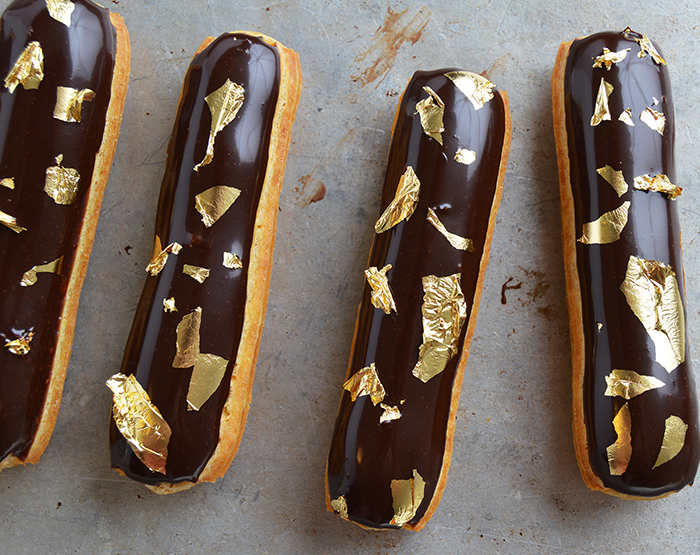
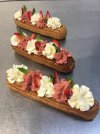
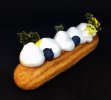
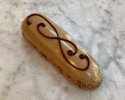
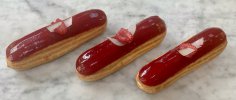
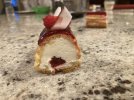
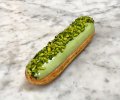
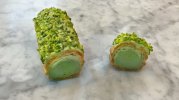
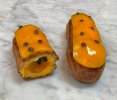
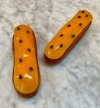
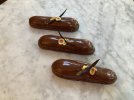
![IMG_20220225_164926[1].jpg](/data/attachments/4/4473-4a6a03d9d29abafc1eb7288ea171d719.jpg)
![IMG_20220317_150850[1].jpg](/data/attachments/4/4474-0cebb776115b9e33898045b91d536014.jpg)